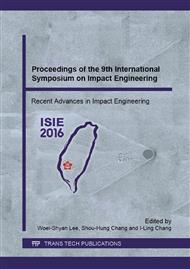p.74
p.80
p.86
p.95
p.101
p.107
p.111
p.116
p.122
Determination of Fracture Toughness by Single and Double Action Tensile Impact Fracture Tests
Abstract:
The characterization of the loading rate dependence of the fracture behavior of polymers is of prime theoretical and practical interest for supporting demanding engineering applications. To gain more insight into the high rate fracture behavior of polymers, fracture tests were performed under tensile loading conditions up to 12 m/s loading rate using a neat model polymer (PVC grey) in this study. A conventional single actuator test set-up for compact tension C(T) specimens was developed based on the previous experience of the authors and implemented on a new high rate servohydraulic testing machine. In addition, a novel double action test set-up was developed by applying two twin actuators and implemented in a rigid horizontal test frame. The conventional load and force measurement was extended by instrumented test specimens and by a high speed optical strain analysis system for both set-ups. Force based fracture toughness values using the peak load values, KIcPL and displacement based values using the critical crack opening displacement (CTOD) KICCTOD were determined up to a loading rate of 10 m/s. While the KIcPL values decreased up to a loading rate 103 MPam1/2s-1 an increase with a high data scatter was observed above them. Corresponding to the CTOD values the calculated KICCTOD values revealed a slight decrease and moderate data scatter up to the maximal loading rate.
Info:
Periodical:
Pages:
101-106
Citation:
Online since:
September 2016
Authors:
Price:
Сopyright:
© 2016 Trans Tech Publications Ltd. All Rights Reserved
Share:
Citation:


